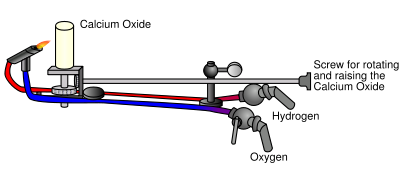
Limelight
Encyclopedia

Stage lighting
Modern stage lighting is a flexible tool in the production of theatre, dance, opera and other performance arts. Several different types of stage lighting instruments are used in the pursuit of the various principles or goals of lighting. Stage lighting has grown considerably in recent years...
once used in theatre
Theatre
Theatre is a collaborative form of fine art that uses live performers to present the experience of a real or imagined event before a live audience in a specific place. The performers may communicate this experience to the audience through combinations of gesture, speech, song, music or dance...
s and music hall
Music hall
Music Hall is a type of British theatrical entertainment which was popular between 1850 and 1960. The term can refer to:# A particular form of variety entertainment involving a mixture of popular song, comedy and speciality acts...
s. An intense illumination is created when an oxyhydrogen flame
Oxyhydrogen
Oxyhydrogen is a mixture of hydrogen and oxygen gases, typically in a 2:1 molar ratio, the same proportion as water. This gaseous mixture is used for torches for the processing of refractory materials and was the first gaseous mixture used for welding...
is directed at a cylinder of quicklime (calcium oxide
Calcium oxide
Calcium oxide , commonly known as quicklime or burnt lime, is a widely used chemical compound. It is a white, caustic, alkaline crystalline solid at room temperature....
), which can be heated to 2572 °C before melting. The light is produced by a combination of incandescence
Incandescence
Incandescence is the emission of light from a hot body as a result of its temperature. The term derives from the Latin verb incandescere, to glow white....
and candoluminescence
Candoluminescence
Candoluminescence is the term used to describe the light given off by certain materials which have been heated to incandescence and emit a larger proportion of short wavelength light than would be expected for a typical blackbody radiator...
. Although it has long since been replaced by electric lighting, the term has nonetheless survived, as someone in the public eye is still said to be “in the limelight.” The actual lights are called limes, a term which has been transferred to electrical equivalents.
History
The limelight effect was discovered in the 1820s by Goldsworthy GurneyGoldsworthy Gurney
Sir Goldsworthy Gurney was a surgeon, chemist, lecturer, consultant, architect, builder and prototypical British gentleman scientist and inventor of the Victorian period....
, based on his work with the "oxy-hydrogen blowpipe
Blowpipe (tool)
The term blowpipe refers to one of several tools used to direct streams of gases into any of several working media.- Blowpipes for torches :...
," credit for which is normally given to Robert Hare
Robert Hare (chemist)
Robert Hare was an early American chemist.Hare was born in Philadelphia, Pennsylvania on January 17, 1781. He developed and experimented with the oxy-hydrogen blowpipe, with Edward Daniel Clarke of Oxford, shortly after 1800. He married Harriett Clark and had six children...
. In 1825, a Scottish
Scotland
Scotland is a country that is part of the United Kingdom. Occupying the northern third of the island of Great Britain, it shares a border with England to the south and is bounded by the North Sea to the east, the Atlantic Ocean to the north and west, and the North Channel and Irish Sea to the...
engineer, Thomas Drummond
Thomas Drummond
Captain Thomas Drummond , from Edinburgh, Scotland, was an army officer, civil engineer and senior public official. Drummond used the Drummond light which was employed in the trigonometrical survey of Great Britain and Ireland. He is sometimes mistakenly given credit for the invention of limelight,...
(1797–1840), saw a demonstration of the effect by Michael Faraday
Michael Faraday
Michael Faraday, FRS was an English chemist and physicist who contributed to the fields of electromagnetism and electrochemistry....
and realized that the light would be useful for surveying. Drummond built a working version in 1826, and the device is sometimes called the Drummond Light after him.
Limelight was first used in public in the Covent Garden Theatre
Royal Opera House
The Royal Opera House is an opera house and major performing arts venue in Covent Garden, central London. The large building is often referred to as simply "Covent Garden", after a previous use of the site of the opera house's original construction in 1732. It is the home of The Royal Opera, The...
in London
London
London is the capital city of :England and the :United Kingdom, the largest metropolitan area in the United Kingdom, and the largest urban zone in the European Union by most measures. Located on the River Thames, London has been a major settlement for two millennia, its history going back to its...
in 1837 and enjoyed widespread use in theatres around the world in the 1860s and 1870s. Limelights were employed to highlight solo performers in the same manner as modern followspot
Followspot
A followspot, sometimes known as a spot light, is a powerful stage lighting instrument which projects a bright beam of light onto a performance space. Followspots are controlled by a spotlight operator who follows actors around the stage...
s (spotlights).
Limelight was replaced by electric arc lighting
Arc lamp
"Arc lamp" or "arc light" is the general term for a class of lamps that produce light by an electric arc . The lamp consists of two electrodes, first made from carbon but typically made today of tungsten, which are separated by a gas...
in the late 19th century.
See also
- Klieg lightKlieg lightA Klieg light is an intense carbon arc lamp especially used in filmmaking. It is named after inventor John H. Kliegl and his brother Anton Tiberius Kliegl. Modern Klieg lights use a tungsten-halogen filament...
- List of light sources
- Timeline of hydrogen technologiesTimeline of hydrogen technologiesTimeline of hydrogen technologies — A timeline of the history of hydrogen technology.-1600s:* 1625 - First description of hydrogen by Johann Baptista van Helmont...

